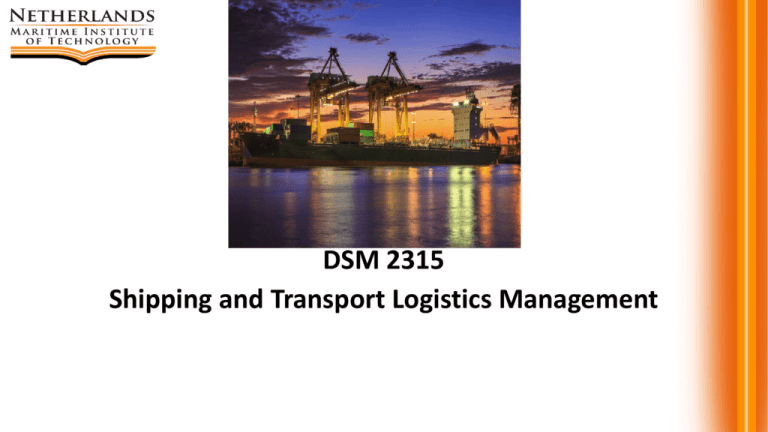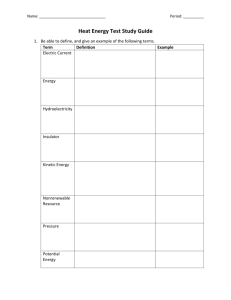DSM 2315 Shipping and Transport Logistics
advertisement

DSM 2315 Shipping and Transport Logistics Management 6. Introduction to Ports Operations 6.1 Ports and terminals 6.2 Terminal design 6.4 Harbor configurations Ports • Ports are places where there are facilities for berthing or anchoring ships and where there is cargo handling equipment to process cargoes from ships to shore, shore to ships, or ships to ships. Important Functions of Ports • Their acting as nodes for linking with other inland transport modes such as highways, railways, and inland waterway systems • Their acting not only as gateways for trade, but also attracting agents of commercial infrastructure such as banks and insurance agents, as well as industrial activities. Kumport Terminal (Istanbul, Turkey) HIBIKI Container Terminal (Japan) Conceptual Design for Yacht Marina and Cruise Terminal, Million Island Project, Koh Lan, Pattaya, 2013 DCT Gdańsk Container Terminal (northern Poland) Port of Odessa (Ukraine) Port of Tomorrow (Marine Transportation System Planning) The Main Facilities In Container Terminals Include: • Quay • Container yard • Container freight station • Gate facility • Interchange area • Rail-head Activities At Container Terminals (Cargo Export Flow): • Receipt/delivery operation Receipt and delivery by road and rail, Packing and Unpacking, Container inspection and cleaning • Container yard operation Storage & in-terminal movements • Quay transfer operation Load and discharge operations • Ship operation Transfer and securing containers and cargo on ship 6. Introduction to Ports Operations 6.3 Port equipment and characteristics Container Handling Equipments (Conbtainer Handlers) Container Handling Equipments (Conbtainer Handlers) • Reach stackers are able to transport a container in short distances very quickly and pile them in various rows depending on its access. • Reach stackers have gained ground in container handling in most markets because of their flexibility and higher stacking and storage capacity when compared to lift trucks. A Rubber Tyred Gantry crane (RTG crane) is a mobile gantry crane used for stacking intermodal containers within the stacking areas of a container terminal. • A Straddle Carrier is a non road going vehicle for use in port terminals and intermodal yards used for stacking and moving ISO standard containers. • These machines have the ability to stack containers up to 4 high. These are capable of relatively low speeds (up to 30km/h) with a laden container. • An RMG travels on rails to lift and stack 20 or 40 containers in the yard area. • These cranes are specifically designed for intensive container stacking due to its automation and less need for human handling. • Compare to the Rubber Tyred Gantry crane (RTG), the RMG has the advantages of being driven by electrical power, cleaner, bigger lifting capacity, and higher gantry traveling speed with cargo. A container crane (also container handling gantry crane, ship-to-shore crane) is a design of large dockside gantry cranes found at container terminals for loading and unloading intermodal containers from container ships. Type of Container Cranes • Container Cranes are generally classified their lifting capacity, and the size of the container ships they can load and unload containers • Panamax : A “Panamax” crane can fully load and unload containers from a container ship capable of passing through Panama Canal (ships of 12-13 container rowswide) • Post Panamax : A “Post-Panamx” crane can fully load and unload containers from a container ship too large (too wide) to pass through the Panama Canal normally about 18 container rowswide). • Super-Post Panamax: The largest modern container cranes are classified as “Super-Post Panamax” (for vessels of about 22 container rows wide and/or more). 6. Introduction to Ports Operations 6.5 Pilotage Pilotage • Pilotage is the use of fixed visual reference on the ground or sea by means of sight or radar to guide oneself to a destination, sometimes with the help of a map or nautical chart. • Pilotage techniques apply when close enough to land or other navigational reference points. • In these circumstances there is often not enough time for more elaborate navigational techniques that are used when out of sight of both navigational aids and hazards. • Also, it is usually not necessary to know exactly where you are, but that one is in a safe position, or at least on a safe line and will remain so for a period of time, and to know when the next change will be required. • Without such pilotage references, it is necessary to navigate using dead reckoning (typically with a compass and some form of log for speed or distance estimation), radar, radio navigation, and satellite navigation (such as GPS). 6. Introduction to Ports Operations 6.6 Port controls Port State Control (PSC) • Port State Control (PSC) is the inspection of foreign ships in other national ports by PSC officers (inspectors) for the purpose of verifying that the competency of the master and officers on board, and the condition of the ship and its equipment comply with the requirements of international conventions (e.g. SOLAS, MARPOL, STCW, etc.) and that the vessel is manned and operated in compliance with applicable international law. 6. Introduction to Ports Operations 6.7 Tugs Tugs • A tugboat (tug) is a boat that maneuvers vessels by pushing or towing them. • Tugs move vessels that either should not move themselves, such as ships in a crowded harbor or a narrow canal, or those that cannot move by themselves, such as barges, disabled ships, log rafts, or oil platforms. • Tugboats are powerful for their size and strongly built, and some are oceangoing. Some tugboats serve as icebreakers or salvage boats. • Early tugboats had steam engines, but today most have diesel engines. • Many tugboats have firefighting monitors, allowing them to assist in firefighting, especially in harbors. Types of tugboats • Seagoing tugboats • Harbour tugboats • River tugboats 6. Introduction to Ports Operations 6.8 Fresh water supply Fresh Water Supply • Fresh water delivery by barge. • A barge is a flat-bottomed boat, built mainly for river and canal transport of heavy goods. Some barges are not self-propelled and need to be towed or pushed by towboats. • By water barge capacity 500mt per delivery 6. Introduction to Ports Operations 6.9 Bunkering Bunkering • Bunkering refers to the process of supplying fuels to ships for their own use. It includes sales for the fuelling of commercial or private boats, such as pleasure crafts and ocean-going vessels, including vessels operated by oil companies. • Spillages and leakages during bunkering operations are a primary source of oil pollution from ships. Experience has shown that many of the bunker overflows and spillages that do occur can be attributed to human error. • Example : Port Klang Bunkering Checklist http://www.pka.gov.my/phocadownload/bunkering%20checklist%20appendi x%20ii.pdf 6. Introduction to Ports Operations 6.10 Shipchandling Shipchandling • A ship chandler (or ship's chandler) is a retail dealer who specialises in supplies or equipment for ships, known as ship's stores. • They supply the crew's food, ship's maintenance supplies, cleaning compounds, rope, et cetera. • The advantage of a ship's crew using a chandler is that they do not have to find stores in the town they have landed in, nor hold that local currency assuming they are let out of the dock compound by the immigration authorities. • Their distinguishing feature is the high level of service demanded and the short time required to fill and deliver their special orders. Because commercial ships discharge and turn around quickly, delay is expensive and the services of a dependable ship chandler are urgent. • chandlery came to refer to a shop selling nautical items for ships and boats. Tariff – Westport (example) • Container Terminal Handling Tariff (example) • http://www.westportsmalaysia.com/Container-@-Container_Tariff.aspx • Marine Services Tariff (example) • • • • Pilotage from pilot station to berth Pilotage from berth to pilot station Towage operation during berthing and unberthing of vessel http://www.westportsmalaysia.com/Marine_Facilities-@Marine_Services_Tariff.aspx





